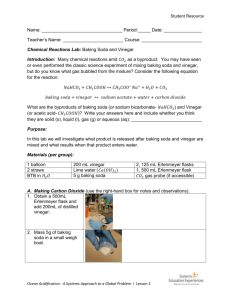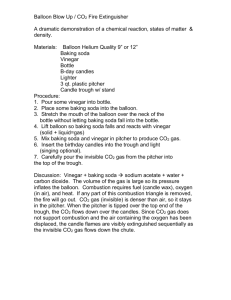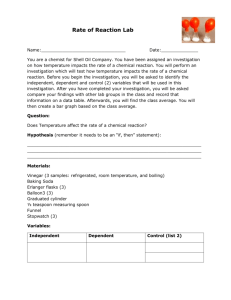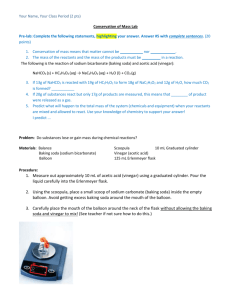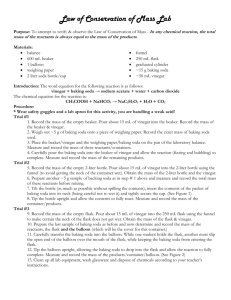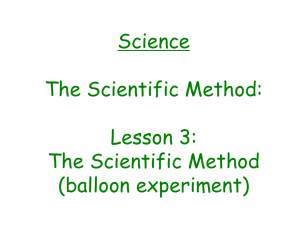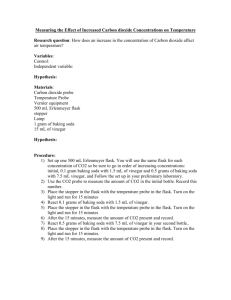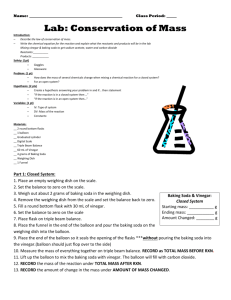Lesson #5: Energy Types and Conversions
advertisement
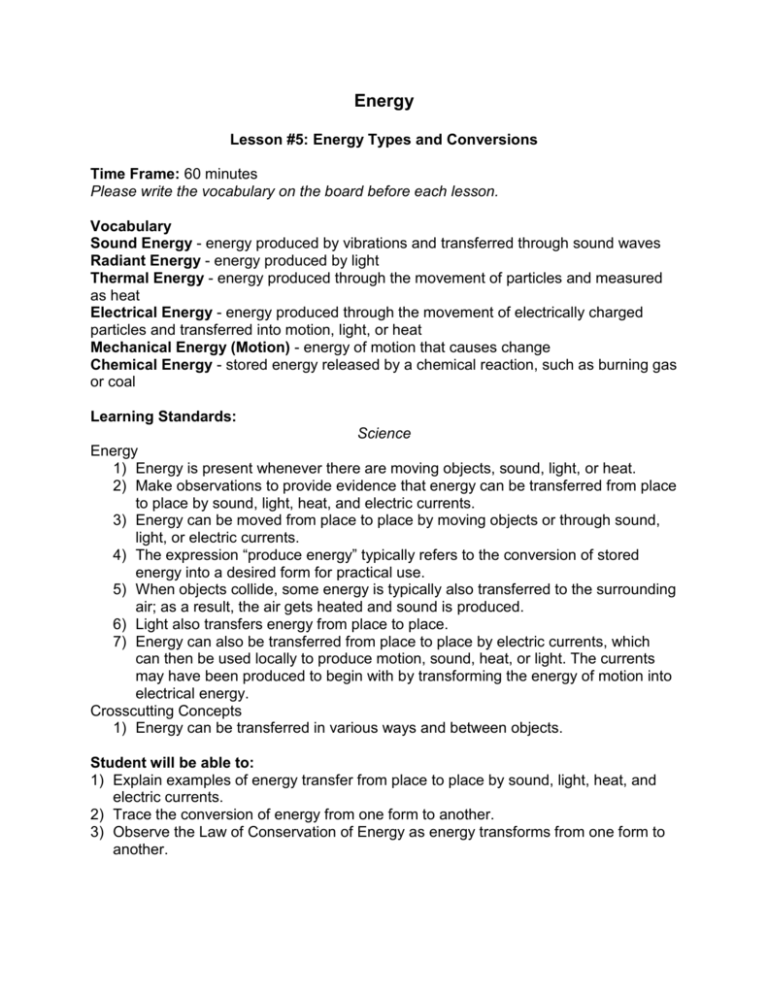
Energy Lesson #5: Energy Types and Conversions Time Frame: 60 minutes Please write the vocabulary on the board before each lesson. Vocabulary Sound Energy - energy produced by vibrations and transferred through sound waves Radiant Energy - energy produced by light Thermal Energy - energy produced through the movement of particles and measured as heat Electrical Energy - energy produced through the movement of electrically charged particles and transferred into motion, light, or heat Mechanical Energy (Motion) - energy of motion that causes change Chemical Energy - stored energy released by a chemical reaction, such as burning gas or coal Learning Standards: Science Energy 1) Energy is present whenever there are moving objects, sound, light, or heat. 2) Make observations to provide evidence that energy can be transferred from place to place by sound, light, heat, and electric currents. 3) Energy can be moved from place to place by moving objects or through sound, light, or electric currents. 4) The expression “produce energy” typically refers to the conversion of stored energy into a desired form for practical use. 5) When objects collide, some energy is typically also transferred to the surrounding air; as a result, the air gets heated and sound is produced. 6) Light also transfers energy from place to place. 7) Energy can also be transferred from place to place by electric currents, which can then be used locally to produce motion, sound, heat, or light. The currents may have been produced to begin with by transforming the energy of motion into electrical energy. Crosscutting Concepts 1) Energy can be transferred in various ways and between objects. Student will be able to: 1) Explain examples of energy transfer from place to place by sound, light, heat, and electric currents. 2) Trace the conversion of energy from one form to another. 3) Observe the Law of Conservation of Energy as energy transforms from one form to another. Resources and Materials: Item Science Journals iPads Energy conversions Station Instructions student handout Energy conversions Student Record Sheet Forms of Energy handout Dynamo Illuminator Wind-up LED Flashlight Music box Container with lid Sand Thermometer Vinegar Baking soda Erlenmeyer flasks Balloons Graduated cylinders Funnels Teaspoons Amount 25 (in bin) 25 (in bin) 25 (in bin) 1 (in bin) 1 (in bin) 2 (in bin) 2 bags (in bin) 2 (in bin) 1 bottle (in bin) 1 box (in bin) 2 (in bin) 1 bag (in bin) 2 (in bin) 2 (in bin) 2 (in bin) Focus Activity: Watch this Rube Goldberg machine demonstration: http://www.tubechop.com/watch/1360565 Introduction: Reiterate the Law of Conservation of Energy and Newton's Laws. Explain what happened with each of the Rube Goldberg devices in the focus activity (in terms of collisions, potential energy, and kinetic energy). Talk about Law of Conservation using different forms of energy, rather than only transferring mechanical energy from one object to another. Have students brainstorm different types of energy. Pass out the “Forms of Energy” handout to the students, and introduce students to the different forms that energy can take. Tell students that today we will be focusing on the six highlighted forms of energy: chemical energy, radiant energy, thermal energy, motion (mechanical energy), sound energy, and electrical energy. Activity: 1) Split students into 4 groups, one at each of the different stations, in order to explore and observe types of energy and energy conversions. Each student should have one copy of the station instructions and one copy of the student record sheet. Give students 8 minutes at each station before rotating to the next station. At each station, students will be asked to figure out which types of energy are involved in the energy conversions. Some stations will also include extensions that will allow students to see the difference between low and high amounts of energy at play. Station #1: Mechanical to electric to light – wind up flashlight The students will be provided with a Dynamo Illuminator Wind-up LED Flashlight at this station. Students will take turns experimenting with how long the flashlight remains illuminated in relation to how many full cycles students turn the crank. The more cycles they wind up the crank, the more mechanical energy they are putting into the system, and the longer the light should remain bright. Students should see the correlation between the input mechanical energy and the output light energy, reinforcing the concept behind the Law of Conservation. On their student activity sheet, students should record the amount of time the flashlight stays lit after turning the crank 1 cycle, 2 cycles, 3 cycles, and so on. Students should use the timer app on the iPads. Teacher Explanation: The crank flashlight contains a small generator, also called a dynamo. When you manually crank the flashlight, a coil of wire inside the generator converts the mechanical energy into electrical energy. This allows an electrical current to flow through the flashlight, thus lighting the bulb of the flashlight. In other words, you are manually charging the battery when you crank the flashlight, and the flashlight still uses the battery to power on. Station #2: Mechanical to sound – music box At this station, there will be a music box that students can wind up in order to see the teeth and comb move, as well as listen to the sounds produced. Have students try to explain how the music box produces sound. Once the students have made a conjecture, they will explain their ideas to a teacher, who will then tell them what actually happens. Afterwards, have students think about the different instruments they have played in music class, and try to adapt the explanation for the music box to explain how their instruments make sounds. The teacher should be sure to emphasize that sound energy comes from the vibration of air against another object. Teacher Explanation: If you took a music box apart, you'd find that there's a tiny cylinder inside that is covered with tiny little bumps, or pins. A springdriven motor causes the cylinder to rotate. As it turns, the pins on the cylinder catch the teeth of a comb in a specific sequence. The vibration of the specific teeth on the comb (of different masses and elasticities) creates the music we hear. Station #3: Mechanical to thermal – sand jar Put the open containers of sand on the table. One container should be completely full of sand, so that little movement of the sand is possible, while the other should be about ⅓ full. Measure and record the initial temperatures of the sand. Compare these two temperatures. Ask students to make hypotheses about what would happen to the temperatures of the sand if we were to shake the containers. Put lids on the containers and shake the sand for about 2 minutes. Make sure to shake the two containers for the same amount of time and that everyone gets a chance to shake the containers. Take off the lids afterwards and measure and record the final temperatures of the sand. Find the change in temperature for each container. Compare the changes in temperature and discuss why they might be different. Teacher Explanation: When we shake the container of sand, the grains of sand move against one another. This movement causes friction, which transforms the mechanical energy of the shaking into heat energy that raises the temperature of the sand. The container with less sand should heat up more because the sand inside is more free to move and collects more kinetic energy than the sand in the full container. Station #4: Chemical to mechanical – baking soda and vinegar balloons Note: Either a Williams student or the classroom teacher should always be watching over this station to help students with the setup and cleanup. Students will be using baking soda and vinegar to create a chemical reaction that will blow up a balloon. Each group will use two flasks, each containing 100 mL of vinegar, and different amounts of baking soda to blow up two balloons. Students will use ½ teaspoon of baking soda with the first flask and 1 ½ teaspoons of baking soda with the second flask. Using a funnel, students will put the measured baking soda into the balloon and attach the balloons to the flasks before letting the baking soda mix with the vinegar in the flask. After the chemical reaction is complete, students should see that the balloon attached to the first flask is smaller than the balloon attached to the second flask. This is because more baking soda (the limiting reagent) was used in blowing up the second balloon. Again, this emphasizes the Law of Conservation of Energy. More chemical reagents means more chemical energy, which is transformed to more mechanical energy capable of blowing a bigger balloon. Teacher Explanation: The vinegar reacts with baking soda, turning into carbon dioxide and water. The carbon dioxide created during the chemical reaction adds pressure to the space inside the flask, causing the balloons to expand outward. Pressure is characteristic of mechanical energy. The more chemical reagents available for the chemical reaction, the more chemical energy is released to transform into the mechanical energy that blows up the balloon. 2) After the students have rotated through all the stations, the teacher will gather their attention back to the front of the classroom to talk about the energy conversions they saw at every station. Students are also encouraged to offer any interesting observations or surprising findings from any of the stations. Closure: Discuss the following scenario: A driver is leisurely driving on a mountain road, when all of a sudden a moose pops out of nowhere. The driver slams down on his breaks, and the car comes to a screeching stop right in front of the moose. Thankfully, neither driver nor moose is injured during this incident. However, the car was moving so fast that you could see sparks if you looked really closely and car’s tires left dark scorch marks on the road. Where did all the mechanical kinetic energy of the moving car go when the car stopped? Teacher Explanation: The mechanical kinetic energy of the moving car converted into other forms of energy, including sound energy (the screeching tires), radiant energy (the sparks), thermal energy (which left the scorch marks), and mechanical energy (that moved in the opposite direction of the car to slow and eventually stop it). Assessment: experiment sheet, participation, science notebooks Energy Conversions Station Instructions Today we will be looking at different types of energy and energy conversions. Remember to take notes about your observations in your science journals and answer the questions on your student record sheets as you work! Station 1: Flashlight 1) There is a hand cranked flashlight at this station. Turn the crank once and see what happens. 2) While one person is timing, another person should turn the crank exactly 1 cycle. Time the light to see how long it lasts. Record this information in your notebooks. What do you think would happen if you turned the crank more than 1 cycle? 3) Switch roles so that everyone gets to try different jobs. Now time and record how long the light from 2 crank cycles lasts. Try again, this time cranking the flashlight 3 full cycles. What is happening as you crank the flashlight more? Station 2: Instrument 1) Have you ever seen inside a music box, or wondered how they work? There is a windup music box at this station. Try winding it up. 2) What happened when you wound up the music box? How did it work? Ask a teacher to see if your hypothesis was correct! 3) Think about the other musical instruments you know of. Can you explain how they work, using your hypothesis about how the music box works? Discuss with your group. Station 3: Sand Jar 1) Notice that there are two bins with sand in them. Observe how these two bins are different. 2) Using the thermometers, measure and record the temperature of the sand in each bin. These are the initial temperatures of the sand. Are they the same or different? After you finish measuring, take the thermometers out. 3) Put the lids on the bins and take turns shaking the bins. Pass both bins around to all your group members. Make sure you shake both bins for the same amount of time. Remember to keep your motions as similar as possible. 4) When you’re done shaking, take off the lids and measure the temperatures again. These are the final temperatures of the sand. Find the change in temperature of both bins of sand by subtracting the initial temperatures from the final temperatures. Station 4: Balloons 1) There are two flasks at this station. If you have 3 people in your group, one person will measure out the baking soda for one balloon, the second person will measure out the baking soda for the second balloon, and the third person will measure out and pour the vinegar for both flasks. If you have 4 people in your group then the third person will only measure out and pour the vinegar for one flask, and the fourth person will measure out and pour the vinegar for the second flask. 2) Remember that the instruments you will be working with are tools, not toys, so be careful! a. Balloon people: If you are working balloons, you will be in charge of measuring out the correct amount of baking soda for each balloon. Then you will use the funnels to pour this baking soda into the balloon. After the vinegar has been poured into the flasks, you will put the balloon securely over the top of the flask. Each balloon gets its own flask. The “top” of the balloon, where the baking soda is, should hang down because it is heavy. Once you have made sure the balloon covers the entire top of the flask, lift this part of the balloon so that the baking soda falls down into the flask. One of the balloon people should measure out ½ teaspoon of baking soda. The other should measure 1 ½ teaspoon of baking soda. Make sure you know which amount you are measuring. b. Vinegar people: If you are working on vinegar, you will be in charge of measuring out the correct amount of vinegar for each flask. Use the graduated cylinders and pour up to the line on the cylinders that says “100 mL”. Then you will pour the vinegar into the flask. Name:_______________________________________ Date:______________ Energy Conversions Student Record Sheet Record your observations while working at the different stations. Continue to think about the following questions: Which types of energy did you observe? Was energy transferred from one place to another? From one type to another? Station 1: Flashlight 1. What happens when you turn the crank? 2. What type of energy are you applying to the crank? 3. What type of energy does the flashlight produce? 4. What happened to the length of time that the light stayed on when you cranked the flashlight more? Why do you think this happened? Can you explain it in terms of the Law of Conservation of Energy? 5. What energy conversion did you observe in this experiment? Station 2: Instrument 1. What type of energy are you applying to the music box? 2. What type of energy does the music box produce? 3. How does the music box work? 4. What energy conversion did you observe in this experiment? Station 3: Sand Jar 1. How are the two bins of sand different? 2. What is the initial temperature of each bin? 3. What is the final temperature of each bin? 4. What is the change in temperature of each bin? (change in temperature = final temperature - initial temperature) 5. Did the bins of sand have the same change in temperature? Why do you think this happened? 6. What energy conversion did you observe in this experiment? Station 4: Balloons 1. What happened in this experiment? 2. Why do you think one balloon was bigger than the other? 3. What type of energy did mixing the baking soda and vinegar create? 4. What type of energy made the balloons expand? 5. What energy conversion did you observe in this experiment?

